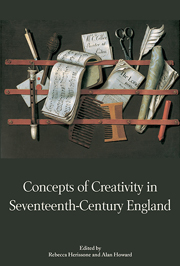Book contents
- Frontmatter
- Contents
- List of Illustrations
- List of Contributors
- Preface
- Introduction
- Creating to Order: Patronage and the Creative Act
- Creative Identity and the Role of Print Media
- Mapping Knowledge: The Visual Representation of Ideas
- Authorial Identity
- 7 Telling what is Told: Originality and Repetition in Rubens's English Works
- 8 Plagiarism at the Academy of Ancient Music: A Case Study in Authorship, Style and Judgement
- Imitation and Arrangement
- The Performer as Creator
- Bibliography
- Index
7 - Telling what is Told: Originality and Repetition in Rubens's English Works
from Authorial Identity
Published online by Cambridge University Press: 05 March 2014
- Frontmatter
- Contents
- List of Illustrations
- List of Contributors
- Preface
- Introduction
- Creating to Order: Patronage and the Creative Act
- Creative Identity and the Role of Print Media
- Mapping Knowledge: The Visual Representation of Ideas
- Authorial Identity
- 7 Telling what is Told: Originality and Repetition in Rubens's English Works
- 8 Plagiarism at the Academy of Ancient Music: A Case Study in Authorship, Style and Judgement
- Imitation and Arrangement
- The Performer as Creator
- Bibliography
- Index
Summary
When a Master doth a thing a second time, lightly it is for the better.
George Gage to Sir Dudley Carleton, 1 November 1617
This chapter will probe early modern notions of creativity by considering the artistic activities, in and for England, of the most sought-after painter in seventeenth-century Europe – Peter Paul Rubens. The artist's busy workshop helped to satisfy the demand for his works, and as a result Rubens's English patrons, ranging from various dignitaries to Charles I himself, were the recipients of paintings with varying degrees of the master's own participation. An inquiry into Rubens's practice of delegating to studio assistants, and into the value placed by him and his British viewers on autography, will elucidate attitudes towards the manual aspects of creation. A related area of investigation will focus on the phenomenon of self-repetition in the artist's works for his English clients, some of which works were replicas of earlier compositions or reused motifs from previous inventions. Finally, a broader exploration of responses to self-replication, extending at times beyond the shores of England or the confines of painting, will bring to the fore the tensions inherent in early modern attitudes to art.
Replicas and Studio Hands
Although Rubens's stay in England as a diplomatic envoy dates to 1629–30, his relationship with English patrons had begun some thirteen years earlier when Sir Dudley Carleton, the English Ambassador to The Hague, had sought to trade a diamond chain for a hunt scene by the artist.
- Type
- Chapter
- Information
- Concepts of Creativity in Seventeenth-Century England , pp. 151 - 180Publisher: Boydell & BrewerPrint publication year: 2013

